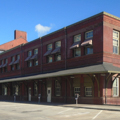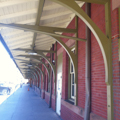You are here
Harrisburg Transportation Center
In 1884, Frank Furness bragged that his stations for the Reading Railroad were being imitated by its competitor, the Pennsylvania Railroad, which had recently hired Powell as staff architect. Powell designed the “Pennsy”'s stations on the Chestnut Hill line in Philadelphia in a way that merged Richardsonian simplification with elements of Furness's work.
Writing Credits
If SAH Archipedia has been useful to you, please consider supporting it.
SAH Archipedia tells the story of the United States through its buildings, landscapes, and cities. This freely available resource empowers the public with authoritative knowledge that deepens their understanding and appreciation of the built environment. But the Society of Architectural Historians, which created SAH Archipedia with University of Virginia Press, needs your support to maintain the high-caliber research, writing, photography, cartography, editing, design, and programming that make SAH Archipedia a trusted online resource available to all who value the history of place, heritage tourism, and learning.











